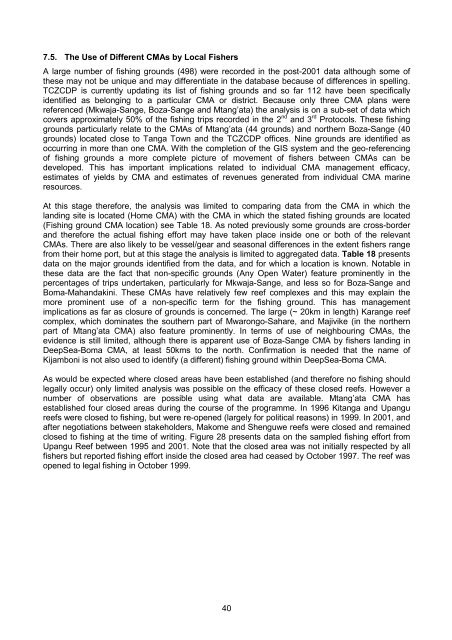Create successful ePaper yourself
Turn your PDF publications into a flip-book with our unique Google optimized e-Paper software.
7.5. The Use of Different CMAs by Local Fishers<br />
A large number of fishing grounds (498) were recorded in the post-2001 data although some of<br />
these may not be unique and may differentiate in the database because of differences in spelling.<br />
TCZCDP is currently updating its list of fishing grounds and so far 112 have been specifically<br />
identified as belonging to a particular CMA or district. Because only three CMA plans were<br />
referenced (Mkwaja-Sange, Boza-Sange and Mtang’ata) the analysis is on a sub-set of data which<br />
covers approximately 50% of the fishing trips recorded in the 2 nd and 3 rd Protocols. These fishing<br />
grounds particularly relate to the CMAs of Mtang’ata (44 grounds) and northern Boza-Sange (40<br />
grounds) located close to <strong>Tanga</strong> Town and the TCZCDP offices. Nine grounds are identified as<br />
occurring in more than one CMA. With the completion of the GIS system and the geo-referencing<br />
of fishing grounds a more complete picture of movement of fishers between CMAs can be<br />
developed. This has important implications related to individual CMA management efficacy,<br />
estimates of yields by CMA and estimates of revenues generated from individual CMA marine<br />
resources.<br />
At this stage therefore, the analysis was limited to comparing data from the CMA in which the<br />
landing site is located (Home CMA) with the CMA in which the stated fishing grounds are located<br />
(Fishing ground CMA location) see Table 18. As noted previously some grounds are cross-border<br />
and therefore the actual fishing effort may have taken place inside one or both of the relevant<br />
CMAs. There are also likely to be vessel/gear and seasonal differences in the extent fishers range<br />
from their home port, but at this stage the analysis is limited to aggregated data. Table 18 presents<br />
data on the major grounds identified from the data, and for which a location is known. Notable in<br />
these data are the fact that non-specific grounds (Any Open Water) feature prominently in the<br />
percentages of trips undertaken, particularly for Mkwaja-Sange, and less so for Boza-Sange and<br />
Boma-Mahandakini. These CMAs have relatively few reef complexes and this may explain the<br />
more prominent use of a non-specific term for the fishing ground. This has management<br />
implications as far as closure of grounds is concerned. The large (~ 20km in length) Karange reef<br />
complex, which dominates the southern part of Mwarongo-Sahare, and Majivike (in the northern<br />
part of Mtang’ata CMA) also feature prominently. In terms of use of neighbouring CMAs, the<br />
evidence is still limited, although there is apparent use of Boza-Sange CMA by fishers landing in<br />
DeepSea-Boma CMA, at least 50kms to the north. Confirmation is needed that the name of<br />
Kijamboni is not also used to identify (a different) fishing ground within DeepSea-Boma CMA.<br />
As would be expected where closed areas have been established (and therefore no fishing should<br />
legally occur) only limited analysis was possible on the efficacy of these closed reefs. However a<br />
number of observations are possible using what data are available. Mtang’ata CMA has<br />
established four closed areas during the course of the programme. In 1996 Kitanga and Upangu<br />
reefs were closed to fishing, but were re-opened (largely for political reasons) in 1999. In 2001, and<br />
after negotiations between stakeholders, Makome and Shenguwe reefs were closed and remained<br />
closed to fishing at the time of writing. Figure 28 presents data on the sampled fishing effort from<br />
Upangu Reef between 1995 and 2001. Note that the closed area was not initially respected by all<br />
fishers but reported fishing effort inside the closed area had ceased by October 1997. The reef was<br />
opened to legal fishing in October 1999.<br />
40
















